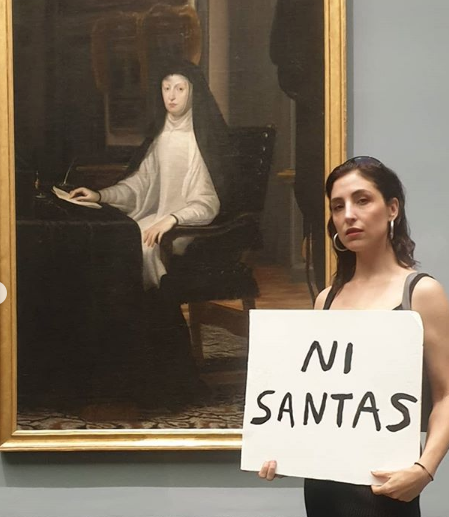Politics
See Why One Feminist Artist’s Protest of Old Master Depictions of Women at the Prado Museum Went Instantly Viral
Anastasia Bengoechea held up signs to protest sexual stereotyping at the Madrid museum.

Anastasia Bengoechea held up signs to protest sexual stereotyping at the Madrid museum.

Sarah Cascone

A feminist writer and cartoonist in Spain has caused a social-media sensation by sharing photos of Old Master paintings from the Museo del Prado’s collection alongside her own hand-painted signs that declare the depicted women “not whores” and “not saints” as a protest against virgin-whore stereotyping.
The artist, Anastasia Bengoechea, posed with her placards in front of Guido Reni’s painting of Cleopatra, in which a snake lunges at the Egyptian queen’s nipple, and Juan Carreño de Miranda’s portrait of a pale and placid-looking Queen Mariana of Austria. The phrases were written in Spanish, ni putas and ni santas (the Spanish saying continues, solo mujeres). Bengoechea’s Instagram post, which assured the Prado it was “still my favorite place in Madrid,” helped “Cleopatra” make the top 20 trending topics in Spain.
The artist, who goes by @monstruoespagueti on social media, has received more than 14,000 likes on the images, which have also been turned into a meme.
“I’m a little surprised of the virality of the picture,” she told artnet News via Instagram. “Being openly and sharply critical about things is the essence of my work.”
Some responses on social media have criticized Bengoechea’s choice of artworks, arguing that Cleopatra wasn’t a whore and Queen Mariana wasn’t a saint, according to La Vangardia. But Bengoechea says she doesn’t mind.
“What I am really enjoying the most about the attention these pictures are having is that everybody is making an interpretation about it,” she said. “Some say I am calling Cleopatra a whore, some make theories about why I pick those paintings, some ask me how did I take the pictures, and that is exactly what keeps the conversation alive.”